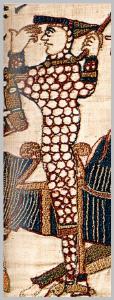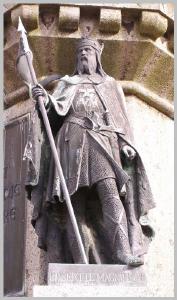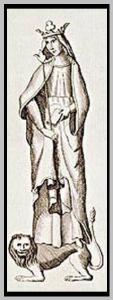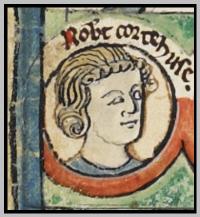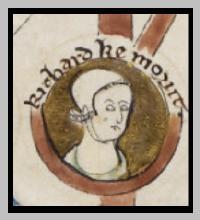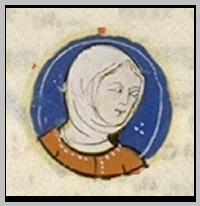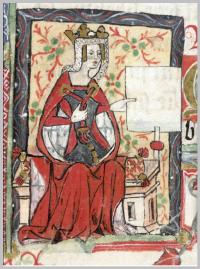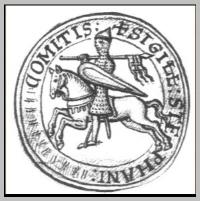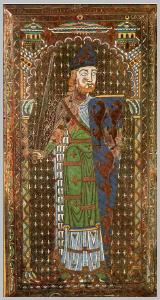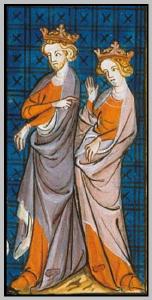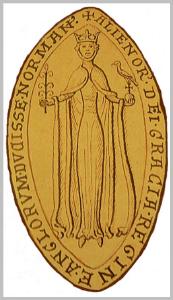William I (?)1
M, b. between 1027 and 1028, d. 9 September 1087
| Father | Robert I (the Magnificent) (?)2 b. 22 Jun 1000, d. bt 1 Jul 1035 - 3 Jul 1035 |
| Mother | Herleva (?)3 b. c 1003, d. c 1050 |
| Charts | Norman Line Relationship between Elizabeth II and William I |
| Last Edited | 30 Jul 2018 |
| Birth* | between 1027 and 1028 | William I (?) was born between 1027 and 1028 at Falaise, Normandy.4 |
| Marriage* | between 1051 and 1052 | He married Matilda (?) of Flanders between 1051 and 1052.5 |
| Death* | 9 September 1087 | William I (?) died on 9 September 1087 at Saint Gervase, Rouen.6 |
| Burial* | 1087 | He was buried in 1087 at Caen.7 |
| Note | He William I, usually known as William the Conqueror and sometimes William the Bastard,[2][b] was the first Norman King of England, reigning from 1066 until his death in 1087. A descendant of Rollo, he was Duke of Normandy from 1035 onward. After a long struggle to establish his power, by 1060 his hold on Normandy was secure, and he launched the Norman conquest of England six years later. The rest of his life was marked by struggles to consolidate his hold over England and his continental lands and by difficulties with his eldest son. William was the son of the unmarried Robert I, Duke of Normandy, by Robert's mistress Herleva. His illegitimate status and his youth caused some difficulties for him after he succeeded his father, as did the anarchy that plagued the first years of his rule. During his childhood and adolescence, members of the Norman aristocracy battled each other, both for control of the child duke and for their own ends. In 1047 William was able to quash a rebellion and begin to establish his authority over the duchy, a process that was not complete until about 1060. His marriage in the 1050s to Matilda of Flanders provided him with a powerful ally in the neighbouring county of Flanders. By the time of his marriage, William was able to arrange the appointment of his supporters as bishops and abbots in the Norman church. His consolidation of power allowed him to expand his horizons, and by 1062 William secured control of the neighbouring county of Maine. In the 1050s and early 1060s William became a contender for the throne of England, then held by the childless Edward the Confessor, his first cousin once removed. There were other potential claimants, including the powerful English earl Harold Godwinson, who was named the next king by Edward on the latter's deathbed in January 1066. William argued that Edward had previously promised the throne to him and that Harold had sworn to support William's claim. William built a large fleet and invaded England in September 1066, decisively defeating and killing Harold at the Battle of Hastings on 14 October 1066. After further military efforts William was crowned king on Christmas Day 1066, in London. He made arrangements for the governance of England in early 1067 before returning to Normandy. Several unsuccessful rebellions followed, but by 1075 William's hold on England was mostly secure, allowing him to spend the majority of the rest of his reign on the continent. William's final years were marked by difficulties in his continental domains, troubles with his eldest son, and threatened invasions of England by the Danes. In 1086 William ordered the compilation of the Domesday Book, a survey listing all the landholdings in England along with their pre-Conquest and current holders. William died in September 1087 while leading a campaign in northern France, and was buried in Caen. His reign in England was marked by the construction of castles, the settling of a new Norman nobility on the land, and change in the composition of the English clergy. He did not try to integrate his various domains into one empire but instead continued to administer each part separately. William's lands were divided after his death: Normandy went to his eldest son, Robert Curthose, and his second surviving son, William Rufus, received England.6 | |
| Name-Variation | William I (?) was also known as William the Bastard.6 | |
| Name-Variation | William I (?) was also known as William the Conqueror.6 | |
| Reign* | between 1066 and 1087 | He reigned between between 1066 and 1087.7 |
| Military-Event* | 14 October 1066 | He participated in a military event on 14 October 1066 Battle of Hastings.6 |
| Coronation* | 25 December 1066 | He was coronated on 25 December 1066 at (?) Westminster.7,6 |
| Note* | William I (?) The medieval chronicler William of Malmesbury says that the king also seized and depopulated many miles of land (36 parishes), turning it into the royal New Forest region to support his enthusiastic enjoyment of hunting. Modern historians have come to the conclusion that the New Forest depopulation was greatly exaggerated. Most of the lands of the New Forest are poor agricultural lands, and archaeological and geographic studies have shown that the New Forest was likely sparsely settled when it was turned into a royal forest.[128] William was known for his love of hunting, and he introduced the forest law into areas of the country, regulating who could hunt and what could be hunted.6 | |
| Event-Misc* | between 25 December 1085 and 1 August 1086 | He was Ordered census for the Domesday Book between 25 December 1085 and 1 August 1086.6 |
Family | Matilda (?) of Flanders b. c 1031, d. 2 Nov 1083 | |
| Children |
| |
Citations
- [S2] Unknown agency, Kings & Queens, p. 9.
- [S4] Robert I, web page, online https://en.wikipedia.org/wiki/Robert_I,_Duke_of_Normandy.
- [S5] Herleva, web page, online https://en.wikipedia.org/wiki/Herleva
- [S1] Personal knowledge of William I (?), 04 Jun 2018.
- [S6] Matelda, web page, online https://en.wikipedia.org/wiki/Matilda_of_Flanders
- [S3] William I web page, online https://en.wikipedia.org/wiki/William_the_Conqueror
- [S2] Unknown agency, Kings & Queens.
Robert I (the Magnificent) (?)1
M, b. 22 June 1000, d. between 1 July 1035 and 3 July 1035
| Last Edited | 9 Jul 2018 |
| Marriage* | Robert I (the Magnificent) (?) married Herleva (?)2 | |
| Birth* | 22 June 1000 | Robert I (the Magnificent) (?) was born on 22 June 1000.1 |
| Death* | between 1 July 1035 and 3 July 1035 | He died between 1 July 1035 and 3 July 1035.1 |
| Name-Variation | Robert I (the Magnificent) (?) was also known as Robert the Magnificent.1 | |
| Name-Variation | Robert I (the Magnificent) (?) was also known as Duke of Normandy.1 | |
| Note* | 1027 | He Robert the Magnificent (French: le Magnifique; at an unknown age 22 June 1000 – 1–3 July 1035), was the Duke of Normandy from 1027 until his death in 1035. Owing to uncertainty over the numbering of the Dukes of Normandy he is usually called Robert I, but sometimes Robert II with his ancestor Rollo as Robert I. He was the son of Richard II and brother of Richard III, who preceded him as the Duke. Less than a year after his father's death, Robert revolted against his brother's rule and deposed him. He was succeeded by his illegitimate son, William the Conqueror who became the first Norman king of England in 1066, following the Norman conquest of England. in 1027.1 |
Family | Herleva (?) b. c 1003, d. c 1050 | |
| Child |
| |
Citations
- [S4] Robert I, web page, online https://en.wikipedia.org/wiki/Robert_I,_Duke_of_Normandy.
- [S3] William I web page, online https://en.wikipedia.org/wiki/William_the_Conqueror
Herleva (?)1
F, b. circa 1003, d. circa 1050
| Last Edited | 7 Jun 2018 |
| Marriage* | Herleva (?) married Robert I (the Magnificent) (?)2 | |
| Birth* | circa 1003 | Herleva (?) was born circa 1003.1 |
| Death* | circa 1050 | She died circa 1050.1 |
| Name-Variation | Herleva (?) was also known as (?) She was also known as Herleve,[1] Arlette,[2] Arletta[3] Arlotte,[4] and Harlette.1 |
Family | Robert I (the Magnificent) (?) b. 22 Jun 1000, d. bt 1 Jul 1035 - 3 Jul 1035 | |
| Child |
| |
Citations
- [S5] Herleva, web page, online https://en.wikipedia.org/wiki/Herleva
- [S3] William I web page, online https://en.wikipedia.org/wiki/William_the_Conqueror
Matilda (?) of Flanders1
F, b. circa 1031, d. 2 November 1083
| Charts | Norman Line Relationship between Elizabeth II and William I |
| Last Edited | 5 Jun 2018 |
| Birth* | circa 1031 | Matilda (?) of Flanders was born circa 1031.1 |
| Marriage* | between 1051 and 1052 | She married William I (?), son of Robert I (the Magnificent) (?) and Herleva (?), between 1051 and 1052.1 |
| Death* | 2 November 1083 | Matilda (?) of Flanders died on 2 November 1083.1 |
Family | William I (?) b. bt 1027 - 1028, d. 9 Sep 1087 | |
| Children |
| |
Citations
- [S6] Matelda, web page, online https://en.wikipedia.org/wiki/Matilda_of_Flanders
- [S3] William I web page, online https://en.wikipedia.org/wiki/William_the_Conqueror
Robert II (Duke of Normandy) (?)1
M, b. between 1051 and 1054, d. 10 February 1134
| Father | William I (?)1 b. bt 1027 - 1028, d. 9 Sep 1087 |
| Mother | Matilda (?) of Flanders1 b. c 1031, d. 2 Nov 1083 |
| Charts | Norman Line |
| Last Edited | 9 Jul 2018 |
| Birth* | between 1051 and 1054 | Robert II (Duke of Normandy) (?) was born between 1051 and 1054.1 |
| Marriage* | 1100 | He married Sybilla of Conversano (?) in 1100 at Apulia, Baria.2 |
| Death* | 10 February 1134 | Robert II (Duke of Normandy) (?) died on 10 February 1134.1 |
| Name-Variation | Robert II (Duke of Normandy) (?) was also known as Robert Curthose.3 | |
| Name-Variation | Robert II (Duke of Normandy) (?) was also known as Duke of Normandy.1 | |
| Note* | 1087 | He Robert Curthose, sometimes called Robert II or Robert III, was the Duke of Normandy from 1087 until 1106 and an unsuccessful claimant to the throne of the Kingdom of England. The son of William the Conqueror, Robert's reign as duke is noted for the discord with his brothers William II and Henry I in England. Robert mortgaged his duchy to finance his participation in the First Crusade, where he was an important crusader commander. Eventually, his disagreements with Henry I led to his death in captivity and the absorption of Normandy as a possession of England. in 1087.1 |
| Note | 1101 | He Robert, who invaded in 1101, disputed Henry's control of England; this military campaign ended in a negotiated settlement that confirmed Henry as king. The peace was short-lived, and Henry invaded the Duchy of Normandy in 1105 and 1106, finally defeating Robert at the Battle of Tinchebray. Henry kept Robert imprisoned for the rest of his life. in 1101.4 |
Family | Sybilla of Conversano (?) d. 18 Mar 1103 | |
Citations
- [S3] William I web page, online https://en.wikipedia.org/wiki/William_the_Conqueror
- [S7] Sybilla, web page, online https://en.wikipedia.org/wiki/Sybilla_of_Conversano
- [S4] Robert I, web page, online https://en.wikipedia.org/wiki/Robert_I,_Duke_of_Normandy.
- [S10] Matilda of Scotland, web page, online https://en.wikipedia.org/wiki/Matilda_of_Scotland
(?) Monarch
?
| Last Edited | 5 Jul 2018 |
| Reign* | between 1066 and 1087 | (?) Monarch reigned between between 1066 and 1087.1 |
| Reign* | between 1087 and 1100 | (?) Monarch reigned between between 1087 and 1100.1 |
| Reign* | between 1100 and 1135 | (?) Monarch reigned between between 1100 and 1135.1 |
| Reign* | between 1135 and 1154 | (?) Monarch reigned between between 1135 and 1154.1 |
| Reign* | between 1154 and 1189 | (?) Monarch reigned between between 1154 and 1189.1 |
| Reign* | between 1189 and 1199 | (?) Monarch reigned between between 1189 and 1199.1 |
| Reign* | between 1199 and 1216 | (?) Monarch reigned between between 1199 and 1216.1 |
| Reign* | between 1216 and 1272 | (?) Monarch reigned between between 1216 and 1272.1 |
| Reign* | between 1307 and 1327 | (?) Monarch reigned between between 1307 and 1327.1 |
| Reign* | between 1327 and 1377 | (?) Monarch reigned between between 1327 and 1377.1 |
| Reign* | between 1327 and 1377 | (?) Monarch reigned between between 1327 and 1377.1 |
| Reign* | between 1377 and 1399 | (?) Monarch reigned between between 1377 and 1399. Deposed by Henry Bolingbroke (who became Henry IV).2 |
| Reign* | between 1399 and 1413 | (?) Monarch reigned between between 1399 and 1413.1 |
| Reign* | between 20 March 1413 and 31 August 1422 | (?) Monarch reigned between between 20 March 1413 and 31 August 1422. |
| Reign* | between 20 March 1413 and 31 August 1422 | (?) Monarch reigned between between 20 March 1413 and 31 August 1422. |
| Reign* | between 31 August 1422 and 29 March 1461 | (?) Monarch reigned between between 31 August 1422 and 29 March 1461. Deposed after being defeated at the Battle of Towton on 29 March 1461.3,1 |
| Reign* | between 4 March 1461 and 3 October 1470 | (?) Monarch reigned between between 4 March 1461 and 3 October 1470. Assumed throne after victory at battle of Towton.4 |
| Reign1* | between 3 October 1470 and 4 May 1471 | Breifly restored to the throne he was deposed again afterthe Battle of Tewkesburyon 4 May 1471. His son Edward was killed in this battle. Henry was imprisoned and later killed in the Tower of London.3 |
| Reign1* | between 11 April 1471 and 9 April 1483 | Restored to throne after defeating (Twekesburyon) and later killing Henry VI.4,3 |
| Reign* | between 9 April 1483 and 26 June 1483 | (?) Monarch reigned between between 9 April 1483 and 26 June 1483. Never crowned. Killed in the tower on the presumed order of Richard III.5 |
| Reign* | between 26 June 1483 and 22 August 1485 | (?) Monarch reigned between between 26 June 1483 and 22 August 1485. Killed in the battle of Bosworth Field.5 |
| Reign* | between 21 August 1485 and 21 April 1509 | (?) Monarch reigned between between 21 August 1485 and 21 April 1509. Siezed the crown after defeating and then killing Richard III at Bosworth Field 22 August 1485.6 |
| Reign* | between 21 April 1509 and 28 January 1547 | (?) Monarch reigned between between 21 April 1509 and 28 January 1547.7 |
| Reign* | between 28 January 1547 and 6 July 1553 | (?) Monarch reigned between between 28 January 1547 and 6 July 1553.8,9 |
| Reign* | between 10 July 1553 and 19 July 1553 | (?) Monarch reigned between between 10 July 1553 and 19 July 1553. In June 1553, Edward VI wrote his will, nominating Jane and her male heirs as successors to the Crown in part because his half-sister Mary was Roman Catholic while Jane was Protestant and would support the reformed Church of England, whose foundation Edward claimed to have laid. The will named his half-sisters Mary and Elizabeth illegitimate and removed them from succession. This step subverted their claims under the Third Succession Act. After Edward's death, Jane was proclaimed queen on 10 July 1553 and awaited coronation in the Tower of London. Support for Mary grew very quickly and most of Jane's supporters abandoned her. The Privy Council decided to change sides and proclaimed Mary as queen on 19 July 1553, deposing Lady Jane.9 |
| Reign* | between 6 July 1553 and 17 November 1558 | (?) Monarch reigned between between 6 July 1553 and 17 November 1558.10 |
| Reign* | between 17 November 1558 and 28 March 1603 | (?) Monarch reigned between between 17 November 1558 and 28 March 1603.11 |
| Reign1* | between 24 March 1603 and 27 March 1625 | As James I of England.12 |
| Reign* | between 27 March 1625 and 30 January 1649 | (?) Monarch reigned between between 27 March 1625 and 30 January 1649.13 |
| Reign* | between 29 May 1660 and 6 February 1685 | (?) Monarch reigned between between 29 May 1660 and 6 February 1685. Date of his return to England.14 |
| Reign* | between 6 February 1685 and 23 December 1688 | (?) Monarch reigned between between 6 February 1685 and 23 December 1688. Escaped to France effectively abdicating the throne. Palriament named William and Mary joint monarchs, the creating the Glorious Revolution.15 |
| Reign* | between 13 February 1689 and 28 December 1694 | (?) Monarch reigned between between 13 February 1689 and 28 December 1694. By the decree of parliament in the Declaration of Right, William and Mary were to reign jointly with the crown extending to the survivor on the death of one of them.16 |
| Reign | between 13 February 1689 and 8 March 1702 | (?) Monarch reigned between between 13 February 1689 and 8 March 1702. By the decree of parliament in the Declaration of Right, William and Mary were to reign jointly with the crown extending to the survivor on the death of one of them.16 |
| Reign* | between 8 March 1702 and 1 August 1714 | (?) Monarch reigned between between 8 March 1702 and 1 August 1714.17 |
| Reign* | between 1 August 1714 and 11 June 1727 | (?) Monarch reigned between between 1 August 1714 and 11 June 1727.18 |
| Reign* | between 1 August 1714 and 11 June 1727 | (?) Monarch reigned between between 1 August 1714 and 11 June 1727.18 |
| Reign* | between 11 January 1727 and 28 October 1760 | (?) Monarch reigned between between 11 January 1727 and 28 October 1760.19 |
| Reign* | between 20 October 1760 and 29 January 1820 | (?) Monarch reigned between between 20 October 1760 and 29 January 1820.20 |
| Reign* | between 29 January 1820 and 26 June 1830 | (?) Monarch reigned between between 29 January 1820 and 26 June 1830.21 |
| Reign* | between 26 June 1830 and 20 June 1837 | (?) Monarch reigned between between 26 June 1830 and 20 June 1837.22 |
| Reign* | between 20 June 1837 and 22 January 1901 | (?) Monarch reigned between between 20 June 1837 and 22 January 1901.23 |
| Reign* | between 22 January 1901 and 6 May 1910 | (?) Monarch reigned between between 22 January 1901 and 6 May 1910.24 |
| Reign* | between 6 May 1910 and 20 January 1936 | (?) Monarch reigned between between 6 May 1910 and 20 January 1936.25 |
| Reign* | between 6 May 1910 and 20 January 1936 | (?) Monarch reigned between between 6 May 1910 and 20 January 1936.25 |
Citations
- [S2] Unknown agency, Kings & Queens.
- [S43] Richard II, web page, online https://en.wikipedia.org/wiki/Richard_II_of_England
- [S56] Henry VI , web page, online https://en.wikipedia.org/wiki/Henry_VI_of_England
- [S61] Edward IV of England, web page, online https://en.wikipedia.org/wiki/Edward_IV_of_England
- [S63] Richard III, web page, online https://en.wikipedia.org/wiki/Richard_III_of_England
- [S64] Henry VII, web page, online https://en.wikipedia.org/wiki/Henry_VII_of_England
- [S65] Henry VIII, web page, online https://en.wikipedia.org/wiki/Henry_VIII_of_England
- [S73] Edward VI, web page, online https://en.wikipedia.org/wiki/Edward_VI_of_England
- [S79] Lady Jane Grey, web page, online https://en.wikipedia.org/wiki/Lady_Jane_Grey
- [S72] Mary Tudor Queen of England, web page, online https://en.wikipedia.org/wiki/Mary_I_of_England#Education_and_early_marriage_plans
- [S74] Elizabeth I, web page, online https://en.wikipedia.org/wiki/Elizabeth_I_of_England
- [S87] Matthew Stewart, 4th Earl of Lennox , web page, online https://en.wikipedia.org/wiki/Matthew_Stewart,_4th_Earl_of_Lennox.
- [S89] Charles I of England , web page, online https://en.wikipedia.org/wiki/Charles_I_of_England
- [S90] Charles II of England , web page, online https://en.wikipedia.org/wiki/Charles_II_of_England
- [S92] James II of England , web page, online https://en.wikipedia.org/wiki/James_II_of_England#Accession_to_the_throne
- [S94] Mary II , web page, online https://en.wikipedia.org/wiki/Mary_II_of_England
- [S96] Anne Queen of England, web page, online https://en.wikipedia.org/wiki/Anne,_Queen_of_Great_Britain.
- [S101] George I , web page, online https://en.wikipedia.org/wiki/George_I_of_Great_Britain
- [S103] George II of Great Britain, web page, online https://en.wikipedia.org/wiki/George_II_of_Great_Britain#Marriage
- [S105] George III, web page, online https://en.wikipedia.org/wiki/George_III_of_the_United_Kingdom
- [S106] George IV, web page, online https://en.wikipedia.org/wiki/George_IV_of_the_United_Kingdom
- [S109] William IV, web page, online https://en.wikipedia.org/wiki/William_IV_of_the_United_Kingdom
- [S108] Queen Victoria , web page, online https://en.wikipedia.org/wiki/Queen_Victoria
- [S110] Edward VII, web page, online https://en.wikipedia.org/wiki/Edward_VII
- [S111] George V, web page, online https://en.wikipedia.org/wiki/George_V
Richard (?)1
M, b. before 1056, d. between 1069 and 1075
| Father | William I (?)1 b. bt 1027 - 1028, d. 9 Sep 1087 |
| Mother | Matilda (?) of Flanders1 b. c 1031, d. 2 Nov 1083 |
| Last Edited | 5 Jun 2018 |
| Birth* | before 1056 | Richard (?) was born before 1056.1 |
| Death* | between 1069 and 1075 | He died between 1069 and 1075; Hunting accidest in the 'New Forest.1,2' |
| Note* | He Richard of Normandy (c. 1054 to between 1069 and 1075) was the second son of William the Conqueror, King of England, and Matilda of Flanders. Between 1069 and 1075, Richard died in a hunting accident in the New Forest.[1][2] He was buried at Winchester Cathedral. In a twist of fate, his younger brother, King William Rufus, and a nephew, also named Richard, were also killed in the New Forest twenty-five years later.2 |
Citations
- [S3] William I web page, online https://en.wikipedia.org/wiki/William_the_Conqueror
- [S8] Richard, web page, online https://en.wikipedia.org/wiki/Richard,_son_of_William_the_Conqueror.
William II (?)1
M, b. between 1056 and 1060, d. 2 August 1100
| Father | William I (?)1 b. bt 1027 - 1028, d. 9 Sep 1087 |
| Mother | Matilda (?) of Flanders1 b. c 1031, d. 2 Nov 1083 |
| Charts | Norman Line |
| Last Edited | 30 Jul 2018 |
| Birth* | between 1056 and 1060 | William II (?) was born between 1056 and 1060.1 |
| Death* | 2 August 1100 | He died on 2 August 1100 at New Forest; Killed in a hunting accident in the New Forest. Possibly murdered.1,2 |
| Burial* | 1100 | He was buried in 1100 at Westminster.2 |
| Note | He William II, the third son of William the Conqueror, was King of England from 1087 until 1100, with powers over Normandy, and influence in Scotland. He was less successful in extending control into Wales. William is commonly known as William Rufus (Rufus being Latin for 'the Red'), perhaps because of his red-faced appearance or, more likely, due to having red hair as a child that grew out in later life.[2] at an unknown age William was a figure of complex temperament: capable of both bellicosity and flamboyance. He did not marry, nor did he produce any offspring, legitimate or otherwise, which has led to speculations of possible homosexuality by historians.[4] He died after being struck by an arrow while hunting, under circumstances that remain unclear. Circumstantial evidence in the behaviour of those around him raise strong, but unproven, suspicions of murder.[5] His younger brother Henry I hurriedly succeeded him as king. Barlow says he was "A rumbustious, devil-may-care soldier, without natural dignity or social graces, with no cultivated tastes and little show of conventional religious piety or morality—indeed, according to his critics, addicted to every kind of vice, particularly lust and especially sodomy." On the other hand, he was a wise ruler and victorious general. Barlow finds that, "His chivalrous virtues and achievements were all too obvious. He had maintained good order and satisfactory justice in England and restored good peace to Normandy. He had extended Anglo-Norman rule in Wales, brought Scotland firmly under his lordship, recovered Maine, and kept up the pressure on the Vexin."3 | |
| Reign* | between 1087 and 1100 | He reigned between between 1087 and 1100.2 |
| Coronation* | 1087 | He was coronated in 1087 at (?) Westminster.2 |
| Note | William II (?) Died without issue. Never married, never had a mistriss, never had illegitimate children. Speculated that he was a homosexual.3 | |
| Note | He This is the King of Kingsley lore who got lost in the New Forest.4 |
Citations
- [S3] William I web page, online https://en.wikipedia.org/wiki/William_the_Conqueror
- [S2] Unknown agency, Kings & Queens.
- [S9] William II, web page, online https://en.wikipedia.org/wiki/William_II_of_England
- [S1] Personal knowledge of William I (?), 04 Jun 2018.
Henry I (?)1
M, b. 1068, d. 1 December 1135
| Father | William I (?)1 b. bt 1027 - 1028, d. 9 Sep 1087 |
| Mother | Matilda (?) of Flanders1 b. c 1031, d. 2 Nov 1083 |
| Charts | Norman Line Relationship between Elizabeth II and William I |
| Last Edited | 9 Jul 2018 |
| Birth* | 1068 | Henry I (?) was born in 1068.1 |
| Marriage* | 1100 | He married Matilda (?) of Scotland in 1100.2 |
| Marriage* | 1121 | Henry I (?) married Adeliza of Louvain (?) in 1121.3 |
| Death* | 1 December 1135 | Henry I (?) died on 1 December 1135.1 |
| Note* | He Henry I (c. 1068 – 1 December 1135), also known as Henry Beauclerc, was King of England from 1100 to his death. Henry was the fourth son of William the Conqueror and was educated in Latin and the liberal arts. On William's death in 1087, Henry's elder brothers Robert Curthose and William Rufus inherited Normandy and England, respectively, but Henry was left landless. Henry purchased the County of Cotentin in western Normandy from Robert, but William and Robert deposed him in 1091. Henry gradually rebuilt his power base in the Cotentin and allied himself with William against Robert. Henry was present when William died in a hunting accident in 1100, and he seized the English throne, promising at his coronation to correct many of William's less popular policies. Henry married Matilda of Scotland but continued to have a large number of mistresses by whom he had many illegitimate children.1 | |
| Reign* | between 1100 and 1135 | He reigned between between 1100 and 1135.4 |
| Coronation* | 1100 | He was coronated in 1100 at (?) Westminster.4 |
Family 1 | Matilda (?) of Scotland b. c 1080, d. 1 May 1118 | |
| Children |
| |
Family 2 | Adeliza of Louvain (?) b. c 1103, d. 23 Apr 1151 | |
Citations
- [S3] William I web page, online https://en.wikipedia.org/wiki/William_the_Conqueror
- [S10] Matilda of Scotland, web page, online https://en.wikipedia.org/wiki/Matilda_of_Scotland
- [S15] Adeliza of Louvain, web page, online https://en.wikipedia.org/wiki/Adeliza_of_Louvain
- [S2] Unknown agency, Kings & Queens.
- [S11] Matilda of England , web page, online https://en.wikipedia.org/wiki/Empress_Matilda
- [S12] William Ætheling, web page, online https://en.wikipedia.org/wiki/William_Adelin
Adeliza (?)1
F, d. before 1113
| Father | William I (?)1 b. bt 1027 - 1028, d. 9 Sep 1087 |
| Mother | Matilda (?) of Flanders1 b. c 1031, d. 2 Nov 1083 |
| Last Edited | 5 Jun 2018 |
| Birth* | Adeliza (?) was born. | |
| Death* | before 1113 | She died before 1113.1 |
| Note* | She Adeliza or Adelida (died before 1113)[1] was a daughter of the English king William the Conqueror and his wife, Matilda of Flanders. There is considerable uncertainty about her life, including her dates of birth and death. In a mortuary roll prepared at her sister's religious house, she was listed first among the daughters of William the Conqueror. She was usually the first daughter in lists of William's children, and thus probably the eldest. Her inclusion in the mortuary roll indicates that her death preceded the date of its 1113 compilation.1 |
Citations
- [S3] William I web page, online https://en.wikipedia.org/wiki/William_the_Conqueror
Cecilia (?)1
F, b. before 1066, d. 1127
| Father | William I (?)1 b. bt 1027 - 1028, d. 9 Sep 1087 |
| Mother | Matilda (?) of Flanders1 b. c 1031, d. 2 Nov 1083 |
| Last Edited | 5 Jun 2018 |
| Birth* | before 1066 | Cecilia (?) was born before 1066.1 |
| Death* | 1127 | She died in 1127.1 |
| Note* | She Cecilia of Normandy is thought to be the eldest daughter of William the Conqueror and Matilda of Flanders. Her brothers were Kings William II of England and Henry I of England. She was very close to her other brother, Robert Curthose, and was educated by the abbess Matilda.1 |
Citations
- [S3] William I web page, online https://en.wikipedia.org/wiki/William_the_Conqueror
Constance (?)1
F, d. 1090
| Father | William I (?)1 b. bt 1027 - 1028, d. 9 Sep 1087 |
| Mother | Matilda (?) of Flanders1 b. c 1031, d. 2 Nov 1083 |
| Last Edited | 5 Jun 2018 |
| Birth* | Constance (?) was born. | |
| Death* | 1090 | She died in 1090.1 |
Citations
- [S3] William I web page, online https://en.wikipedia.org/wiki/William_the_Conqueror
Adela (?)1
F, b. circa 1067, d. 1137
| Father | William I (?)1 b. bt 1027 - 1028, d. 9 Sep 1087 |
| Mother | Matilda (?) of Flanders1 b. c 1031, d. 2 Nov 1083 |
| Charts | Norman Line |
| Last Edited | 5 Jun 2018 |
| Burial* | Adela (?) was buried. | |
| Birth* | circa 1067 | She was born circa 1067.1 |
| Marriage* | between 1080 and 1083 | She married Stephen Henry II (Count of Blois) (?) between 1080 and 1083.2,3 |
| Death* | 1137 | Adela (?) died in 1137.1 |
| Note* | She Adela of Normandy, of Blois, or of England (c. 1067[1] – 8 March 1137), also known as Saint Adela in Roman Catholicism,[2] was Countess of Blois, Chartres, and Meaux by marriage to Stephen II, Count of Blois. He greatly benefited from the increased social status and prestige that came with such a marriage. She brought with her not only her title, but a wedding gift of cash and other movable goods from the prodigious store of Anglo-Norman wealth.[3] She was regent of Blois during the absence of her spouse in 1096-1100 and 1101-02, and during the minority of her son from 1102 until 1120. The Anglo-Norman Thibaudian alliance, confirmed in her marriage, was atypossized by Adela as an effective determinant of political action in the almost twenty years she performed as the acknowledged head of the family. This highlights the fact that through to the twelfth century politics were family affairs in which women as creators of families could exercise real power.1 |
Family | Stephen Henry II (Count of Blois) (?) b. c 1045, d. 19 May 1102 | |
| Child |
| |
Citations
- [S3] William I web page, online https://en.wikipedia.org/wiki/William_the_Conqueror
- [S13] Stephen Count of Blois, web page, online https://en.wikipedia.org/wiki/Stephen,_Count_of_Blois.
- [S14] Adela of Normandy, web page, online https://en.wikipedia.org/wiki/Adela_of_Normandy
Matilda (?)1
F, b. circa 1061, d. circa 1086
| Father | William I (?)1 b. bt 1027 - 1028, d. 9 Sep 1087 |
| Mother | Matilda (?) of Flanders1 b. c 1031, d. 2 Nov 1083 |
| Last Edited | 28 Jun 2018 |
| Birth* | circa 1061 | Matilda (?) was born circa 1061.1 |
| Death* | circa 1086 | She died circa 1086.1 |
Citations
- [S3] William I web page, online https://en.wikipedia.org/wiki/William_the_Conqueror
Sybilla of Conversano (?)1
F, d. 18 March 1103
| Last Edited | 14 Jun 2018 |
| Marriage* | 1100 | Sybilla of Conversano (?) married Robert II (Duke of Normandy) (?), son of William I (?) and Matilda (?) of Flanders, in 1100 at Apulia, Baria.1 |
| Death* | 18 March 1103 | Sybilla of Conversano (?) died on 18 March 1103.1 |
| Note* | She She was the daughter of Geoffrey of Brindisi, Count of Conversano (and a grandniece of Robert Guiscard.[1][2] During the winter of 1096-97 while Robert Curthose was in Apulia awaiting transport on the First Crusade, he probably began negotiations to marry the heiress, Sibyl of Conversano.[3] Orderic Vitalis claims Robert 'fell in love with Sibyl and further the chronicler called her 'truly good in character' and also wrote she was 'endowed with many virtues and lovable to all who knew her'. at an unknown age [3] On Robert's return from the Crusade he married Sibylla in Apulia[4] in 1100[1] Shortly after returning to Normandy, Robert and Sybilla undertook a pilgrimage to Mont Saint-Michel to give thanks for his safe return from the Crusade.[5] It is clear that writers of the time were quite taken with Sybilla, praising both her beauty and intelligence.[6] During Curthose's absence, Robert of Torigni noted that the new duchess administered Normandy better than the duke did.[6] On 25 October 1102, their son was born.[7] He was named William for William, Archbishop of Rouen who presided over his baptism, this according to Orderic.[7] William of Malmesbury suggested he was named after his grandfather, William the Conqueror.[7] On 18 March 1103,[8] less than six months after the birth of her only child, she died at Rouen, Caux, and was buried, amid universal sorrow, in the cathedral church, Archbishop William Bonne-Ame performing the funeral rites. Sybilla was admired and often praised by chroniclers of the time; William of Malmesbury claims she died as a result of binding her breasts too tightly while both Robert of Torigny and Orderic Vitalis suggest she was murdered by a group of noblewomen led by her husband's mistress, Agnes de Ribemont.[b][9]1 |
Family | Robert II (Duke of Normandy) (?) b. bt 1051 - 1054, d. 10 Feb 1134 | |
Citations
- [S7] Sybilla, web page, online https://en.wikipedia.org/wiki/Sybilla_of_Conversano
Matilda (?) of Scotland1
F, b. circa 1080, d. 1 May 1118
| Charts | Norman Line Relationship between Elizabeth II and William I |
| Last Edited | 5 Jun 2018 |
| Birth* | circa 1080 | Matilda (?) of Scotland was born circa 1080.1 |
| Marriage* | 1100 | She married Henry I (?), son of William I (?) and Matilda (?) of Flanders, in 1100.1 |
| Death* | 1 May 1118 | Matilda (?) of Scotland died on 1 May 1118.1 |
Family | Henry I (?) b. 1068, d. 1 Dec 1135 | |
| Children |
| |
Citations
- [S10] Matilda of Scotland, web page, online https://en.wikipedia.org/wiki/Matilda_of_Scotland
- [S11] Matilda of England , web page, online https://en.wikipedia.org/wiki/Empress_Matilda
- [S12] William Ætheling, web page, online https://en.wikipedia.org/wiki/William_Adelin
Empress Matilda (?)1,2
F, b. circa 7 February 1102, d. 10 September 1167
| Father | Henry I (?)1 b. 1068, d. 1 Dec 1135 |
| Mother | Matilda (?) of Scotland1 b. c 1080, d. 1 May 1118 |
| Charts | Norman Line Relationship between Elizabeth II and William I |
| Last Edited | 30 Jul 2018 |
| Birth* | circa 7 February 1102 | Empress Matilda (?) was born circa 7 February 1102.1 |
| Marriage* | 7 January 1114 | She married Holy Roman Emperor Henry (?) V on 7 January 1114 at Mainz.3 |
| Marriage* | 17 June 1128 | Empress Matilda (?) married Geoffrey Plantagenet (?) on 17 June 1128 at Le Mans.4,1 |
| Death* | 10 September 1167 | Empress Matilda (?) died on 10 September 1167.1 |
| Burial* | She was buried; buried under the high altar at Bec Abbey.1 | |
| Note* | She Empress Matilda, also known as the Empress Maude,[nb 1] was the claimant to the English throne during the civil war known as the Anarchy. Matilda's younger brother, William Adelin, died in the White Ship disaster of 1120, leaving England facing a potential succession crisis. On her husband, Emperor Henry V's death, Matilda was recalled to Normandy by her father, who arranged for her to marry Geoffrey of Anjou to form an alliance to protect his southern borders. Henry I had no further legitimate children and nominated Matilda as his heir, making his court swear an oath of loyalty to her and her successors, but the decision was not popular in the Anglo-Norman court. Henry died in 1135, but Matilda and Geoffrey faced opposition from the Norman barons and were unable to pursue their claims. The throne was instead taken by Matilda's cousin Stephen of Blois, who enjoyed the backing of the English Church. Stephen took steps to solidify his new regime but faced threats both from neighbouring powers and from opponents within his kingdom.2 | |
| Reign* | She reigned between. Upon the death of Henry I, Matilda becan efforts to advance her cause to become monarch. There was considerable opposition which resulted in a civil war which draged on until 1153 when Matilda's son Henry recognized Steven as king and Steven adopted Henry and made him hier apparent.1 |
Family 1 | Holy Roman Emperor Henry (?) V b. bt 11 Aug 1081 - 1086, d. 23 May 1125 | |
Family 2 | Geoffrey Plantagenet (?) b. 24 Aug 1113, d. 7 Sep 1151 | |
| Children |
| |
Citations
- [S11] Matilda of England , web page, online https://en.wikipedia.org/wiki/Empress_Matilda
- [S16] Empress Matilda, web page, online https://en.wikipedia.org/wiki/Empress_Matilda
- [S17] Henry V - HRE, web page, online https://en.wikipedia.org/wiki/Henry_V,_Holy_Roman_Emperor.
- [S18] Geoffrey Plantagenet, web page, online https://en.wikipedia.org/wiki/Geoffrey_Plantagenet,_Count_of_Anjou.
- [S19] Henry II , web page, online https://en.wikipedia.org/wiki/Henry_II_of_England
William Ætheling (?)1
M, b. 5 August 1103, d. 25 November 1120
| Father | Henry I (?)1 b. 1068, d. 1 Dec 1135 |
| Mother | Matilda (?) of Scotland1 b. c 1080, d. 1 May 1118 |
| Last Edited | 6 Jun 2018 |
| Birth* | 5 August 1103 | William Ætheling (?) was born on 5 August 1103.1 |
| Death* | 25 November 1120 | He died on 25 November 1120 at age 17; without issue. Drowned in the White Ship disaster.1 |
| Note* | He William Ætheling (Old English: [?wi?i?m ?æ?eli?g]; 5 August 1103 – 25 November 1120), commonly called Adelin, sometimes Adelinus, Adelingus, A(u)delin or other Latinised Norman-French variants of Ætheling[1], was the son of Henry I of England by his wife Matilda of Scotland, and was thus heir apparent to the throne. His early death without issue caused a succession crisis, known in history as The Anarchy. He died two years after his mother Matilda of Scotland's death.1 |
Citations
- [S12] William Ætheling, web page, online https://en.wikipedia.org/wiki/William_Adelin
Stephen Henry II (Count of Blois) (?)1
M, b. circa 1045, d. 19 May 1102
| Charts | Norman Line |
| Last Edited | 9 Jul 2018 |
| Birth* | circa 1045 | Stephen Henry II (Count of Blois) (?) was born circa 1045.1 |
| Marriage* | between 1080 and 1083 | He married Adela (?), daughter of William I (?) and Matilda (?) of Flanders, between 1080 and 1083.1,2 |
| Death* | 19 May 1102 | Stephen Henry II (Count of Blois) (?) died on 19 May 1102; killed at the Second Battle of Ramla.1 |
Family | Adela (?) b. c 1067, d. 1137 | |
| Child |
| |
Citations
- [S13] Stephen Count of Blois, web page, online https://en.wikipedia.org/wiki/Stephen,_Count_of_Blois.
- [S14] Adela of Normandy, web page, online https://en.wikipedia.org/wiki/Adela_of_Normandy
Stephen (?)1
M, b. between 1092 and 1096, d. 25 October 1154
| Father | Stephen Henry II (Count of Blois) (?)1 b. c 1045, d. 19 May 1102 |
| Mother | Adela (?)1 b. c 1067, d. 1137 |
| Charts | Norman Line |
| Last Edited | 10 Jun 2018 |
| Birth* | between 1092 and 1096 | Stephen (?) was born between 1092 and 1096.1 |
| Death* | 25 October 1154 | He died on 25 October 1154 at Faversham.1 |
| Reign* | between 1135 and 1154 | He reigned between between 1135 and 1154.2 |
| Coronation* | 22 December 1135 | He was coronated on 22 December 1135 at (?) Westminster.1 |
Citations
- [S13] Stephen Count of Blois, web page, online https://en.wikipedia.org/wiki/Stephen,_Count_of_Blois.
- [S2] Unknown agency, Kings & Queens.
Adeliza of Louvain (?)1
F, b. circa 1103, d. 23 April 1151
| Last Edited | 6 Jun 2018 |
| Birth* | circa 1103 | Adeliza of Louvain (?) was born circa 1103.1 |
| Marriage* | 1121 | She married Henry I (?), son of William I (?) and Matilda (?) of Flanders, in 1121.1 |
| Death* | 23 April 1151 | Adeliza of Louvain (?) died on 23 April 1151; No issue from Henry I.1 |
| Note* | She Adeliza of Louvain,[2] sometimes known in England as Adelicia of Louvain,[3] also called Adela and Aleidis; (c. 1103 – 23 April 1151) was Queen of England from 1121 to 1135, as the second wife of King Henry I.[4] She was the daughter of Godfrey I, Count of Louvain. Henry was some 35 years older than his bride, who was about 18 when they married. He already had children, though no surviving son, from his first marriage to Matilda of Scotland, as well as several illegitimate ones. As his second marriage produced no children he was to leave his throne to his daughter the Empress Matilda. After his death Adeliza spent three years based in a convent, then married again and had seven children by William d'Aubigny, 1st Earl of Arundel. But a year before her death at the age of 48 she left her husband to move to a monastery in Flanders, where at least one of her brothers also lived.1 |
Family | Henry I (?) b. 1068, d. 1 Dec 1135 | |
Citations
- [S15] Adeliza of Louvain, web page, online https://en.wikipedia.org/wiki/Adeliza_of_Louvain
Holy Roman Emperor Henry (?) V1
M, b. between 11 August 1081 and 1086, d. 23 May 1125
| Last Edited | 6 Jun 2018 |
| Birth* | between 11 August 1081 and 1086 | Holy Roman Emperor Henry (?) V was born between 11 August 1081 and 1086.1 |
| Marriage* | 7 January 1114 | He married Empress Matilda (?), daughter of Henry I (?) and Matilda (?) of Scotland, on 7 January 1114 at Mainz.1 |
| Death* | 23 May 1125 | Holy Roman Emperor Henry (?) V died on 23 May 1125; Died without ligetimate issue.1 |
Family | Empress Matilda (?) b. c 7 Feb 1102, d. 10 Sep 1167 | |
Citations
- [S17] Henry V - HRE, web page, online https://en.wikipedia.org/wiki/Henry_V,_Holy_Roman_Emperor.
Geoffrey Plantagenet (?)1
M, b. 24 August 1113, d. 7 September 1151
| Charts | Norman Line Relationship between Elizabeth II and William I |
| Last Edited | 29 Jun 2018 |
| Birth* | 24 August 1113 | Geoffrey Plantagenet (?) was born on 24 August 1113.1 |
| Marriage* | 17 June 1128 | He married Empress Matilda (?), daughter of Henry I (?) and Matilda (?) of Scotland, on 17 June 1128 at Le Mans.1,2 |
| Death* | 7 September 1151 | Geoffrey Plantagenet (?) died on 7 September 1151 at age 38.1 |
| Note* | He Geoffrey V (24 August 1113 – 7 September 1151) — called the Handsome or the Fair (French: le Bel) and Plantagenet — was the Count of Anjou, Touraine, and Maine by inheritance from 1129 and then Duke of Normandy by conquest from 1144. By his marriage to the Empress Matilda, daughter and heiress of Henry I of England, Geoffrey had a son, Henry Curtmantle, who succeeded to the English throne as King Henry II (1154-1189) and was the first of the Plantagenet dynasty to rule England; the name "Plantagenet" was taken from Geoffrey's epithet. His ancestral domain of Anjou gave rise to the name Angevin for three kings of England (Henry II his son and heir, and Henry's sons Richard and John), and what became known as the Angevin Empire in the 12th century.1 |
Family | Empress Matilda (?) b. c 7 Feb 1102, d. 10 Sep 1167 | |
| Children |
| |
Citations
- [S18] Geoffrey Plantagenet, web page, online https://en.wikipedia.org/wiki/Geoffrey_Plantagenet,_Count_of_Anjou.
- [S11] Matilda of England , web page, online https://en.wikipedia.org/wiki/Empress_Matilda
- [S19] Henry II , web page, online https://en.wikipedia.org/wiki/Henry_II_of_England
Henry II (?)1
M, b. 5 March 1133, d. 6 July 1189
| |
| Father | Geoffrey Plantagenet (?)1 b. 24 Aug 1113, d. 7 Sep 1151 |
| Mother | Empress Matilda (?) b. c 7 Feb 1102, d. 10 Sep 1167 |
| Charts | Plantagent Line Relationship between Elizabeth II and William I |
| Last Edited | 29 Jul 2018 |
| Birth* | 5 March 1133 | Henry II (?) was born on 5 March 1133 at Le Mans.1 |
| Marriage* | 18 May 1152 | He married Eleanor of Aquitaine Eleanor (?) on 18 May 1152 at Poitiers Cathedral, Poitiers.2 |
| Death* | 6 July 1189 | Henry II (?) died on 6 July 1189 at age 56.1 |
| Note | He Henry II (5 March 1133 – 6 July 1189), also known as Henry Curtmantle (French: Court-manteau), Henry FitzEmpress or Henry Plantagenet, ruled as Count of Anjou, Count of Maine, Duke of Normandy, Duke of Aquitaine, Count of Nantes, King of England and Lord of Ireland; at various times, he also partially controlled Wales, Scotland and Brittany. Henry was the son of Geoffrey of Anjou and Matilda, daughter of Henry I of England. He became actively involved by the age of 14 in his mother's efforts to claim the throne of England, then occupied by Stephen of Blois, and was made Duke of Normandy at 17. He inherited Anjou in 1151 and shortly afterwards married Eleanor of Aquitaine, whose marriage to Louis VII of France had recently been annulled. Stephen agreed to a peace treaty after Henry's military expedition to England in 1153, and Henry inherited the kingdom on Stephen's death a year later. Henry was an energetic and sometimes ruthless ruler, driven by a desire to restore the lands and privileges of his grandfather Henry I. During the early years of his reign the younger Henry restored the royal administration in England, re-established hegemony over Wales and gained full control over his lands in Anjou, Maine and Touraine. Henry's desire to reform the relationship with the Church led to conflict with his former friend Thomas Becket, the Archbishop of Canterbury. This controversy lasted for much of the 1160s and resulted in Becket's murder in 1170. Henry soon came into conflict with Louis VII and the two rulers fought what has been termed a "cold war" over several decades. Henry expanded his empire, often at Louis' expense, taking Brittany and pushing east into central France and south into Toulouse; despite numerous peace conferences and treaties, no lasting agreement was reached. By 1172, he controlled England, large parts of Wales, the eastern half of Ireland and the western half of France, an area that would later come to be called the Angevin Empire. Henry and Eleanor had eight children. As they grew up, tensions over the future inheritance of the empire began to emerge, encouraged by Louis and his son King Philip II. In 1173 Henry's heir apparent, "Young Henry", rebelled in protest; he was joined by his brothers Richard and Geoffrey and by their mother, Eleanor. France, Scotland, Brittany, Flanders, and Boulogne allied themselves with the rebels. The Great Revolt was only defeated by Henry's vigorous military action and talented local commanders, many of them "new men" appointed for their loyalty and administrative skills. Young Henry and Geoffrey revolted again in 1183, resulting in Young Henry's death. The Norman invasion of Ireland provided lands for his youngest son John, but Henry struggled to find ways to satisfy all his sons' desires for land and immediate power. By 1189, Young Henry and Geoffrey were dead, and Philip successfully played on Richard's fears that Henry II would make John king, leading to a final rebellion. Decisively defeated by Philip and Richard and suffering from a bleeding ulcer, Henry retreated to Chinon castle in Anjou. He died soon and was succeeded by Richard. Henry's empire quickly collapsed during the reign of his youngest son, John. Many of the changes Henry introduced during his long rule, however, had long-term consequences. Henry's legal changes are generally considered to have laid the basis for the English Common Law, while his intervention in Brittany, Wales and Scotland shaped the development of their societies and governmental systems. Historical interpretations of Henry's reign have changed considerably over time. In the 18th century, scholars argued that Henry was a driving force in the creation of a genuinely English monarchy and, ultimately, a unified Britain. During the Victorian expansion of the British Empire, historians were keenly interested in the formation of Henry's own empire, but they also expressed concern over his private life and treatment of Becket. Late-20th-century historians have combined British and French historical accounts of Henry, challenging earlier Anglo-centric interpretations of his reign.1 | |
| Note | He See Henry II Link (38) for Norman connection. | |
| Name-Variation | Henry II (?) was also known as Henry Curtmantle.1 | |
| Reign* | between 1154 and 1189 | He reigned between between 1154 and 1189.3 |
| Coronation* | 1154 | He was coronated in 1154 at (?) Westminster.3 |
| Note* | 29 December 1170 | Henry II (?) Thomas Becket murdered. Becket excommunicated three supporters of Henry: the King was furious and infamously announced "What miserable drones and traitors have I nourished and promoted in my household, who let their lord be treated with such shameful contempt by a low-born clerk!" In response, four knights made their way secretly to Canterbury, apparently with the intent of confronting and if necessary arresting Becket for breaking his agreement with Henry.[258] The Archbishop refused to be arrested by relatively low-born knights, so they hacked him to death on 29 December 1170.[259] This event, particularly in front of an altar, horrified Christian Europe. Although Becket had not been popular while he was alive, in death he was declared a martyr by the local monks.[260] Louis seized on the case, and, despite efforts by the Norman church to prevent the French church from taking action, a new interdict was announced on Henry's possessions.[261] Henry was focused on dealing with Ireland and took no action to arrest Becket's killers, arguing that he was unable to do so.[262] International pressure on Henry grew, and in May 1172 he negotiated a settlement with the papacy in which the King swore to go on crusade as well as effectively overturning the Constitutions of Clarendon.[263] In the coming years, although Henry never actually went on crusade, he exploited the growing "cult of Becket" for his own ends.[264] on 29 December 1170 at Canterbury cathedral, Canterbury.1 |
| Note* | between 1173 and 6 July 1189 | He and Eleanor of Aquitaine Eleanor (?) Eleanor was imprisoned by Henry II because she supported her son Henry in a revolt agains him. between 1173 and 6 July 1189.2 |
Family | Eleanor of Aquitaine Eleanor (?) b. 1122, d. 1 Apr 1204 | |
| Children |
| |
Citations
- [S19] Henry II , web page, online https://en.wikipedia.org/wiki/Henry_II_of_England
- [S20] Eleanor of Aquitaine , web page, online https://en.wikipedia.org/wiki/Eleanor_of_Aquitaine
- [S2] Unknown agency, Kings & Queens.
Eleanor of Aquitaine Eleanor (?)1
F, b. 1122, d. 1 April 1204
| Charts | Plantagent Line Relationship between Elizabeth II and William I |
| Last Edited | 29 Jul 2018 |
| Birth* | 1122 | Eleanor of Aquitaine Eleanor (?) was born in 1122.1 |
| Marriage* | 1137 | She married Louis VII of Franks (?) in 1137.2 |
| Marriage* | 18 May 1152 | Eleanor of Aquitaine Eleanor (?) married Henry II (?), son of Geoffrey Plantagenet (?) and Empress Matilda (?), on 18 May 1152 at Poitiers Cathedral, Poitiers.1 |
| Death* | 1 April 1204 | Eleanor of Aquitaine Eleanor (?) died on 1 April 1204.1 |
| Note* | She Eleanor of Aquitaine (French: Aliénor d'Aquitaine, Éléonore, Latin: Alienora; 1122 – 1 April 1204) was queen consort of France (1137–1152) and England (1154–1189) and duchess of Aquitaine in her own right (1137–1204). As a member of the Ramnulfids (House of Poitiers) rulers in southwestern France, she was one of the most powerful and wealthiest women in western Europe during the High Middle Ages. She was patron of literary figures such as Wace, Benoît de Sainte-Maure, and Bernart de Ventadorn. She led armies several times in her life and was a leader of the Second Crusade.1 | |
| Note | She Eleanor of Aquitaine (French: Aliénor d'Aquitaine, Éléonore, Latin: Alienora; 1124 – 1 April 1204) was queen consort of France (1137–1152) and England (1154–1189) and duchess of Aquitaine in her own right (1137–1204). As a member of the Ramnulfids (House of Poitiers) rulers in southwestern France, she was one of the most powerful and wealthiest women in western Europe during the High Middle Ages. She was patron of literary figures such as Wace, Benoît de Sainte-Maure, and Bernart de Ventadorn. She led armies several times in her life and was a leader of the Second Crusade. As duchess of Aquitaine, Eleanor was the most eligible bride in Europe. Three months after becoming duchess upon the death of her father, William X, she married King Louis VII of France, son of her guardian, King Louis VI. As queen of France, she participated in the unsuccessful Second Crusade. Soon afterwards, Eleanor sought an annulment of her marriage,[1] but her request was rejected by Pope Eugene III.[2] However, after the birth of her second daughter Alix, Louis agreed to an annulment, as 15 years of marriage had not produced a son.[3] The marriage was annulled on 21 March 1152 on the grounds of consanguinity within the fourth degree. Their daughters were declared legitimate, custody was awarded to Louis, and Eleanor's lands were restored to her. As soon as the annulment was granted, Eleanor became engaged to the duke of Normandy, who became King Henry II of England in 1154. Henry was her third cousin and 11 years younger. The couple married on Whitsun, 18 May 1152, eight weeks after the annulment of Eleanor's first marriage, in Poitiers Cathedral. Over the next 13 years, she bore eight children: five sons, three of whom became kings; and three daughters. However, Henry and Eleanor eventually became estranged. Henry imprisoned her in 1173 for supporting their son Henry's revolt against him. She was not released until 6 July 1189, when Henry died and their second son, Richard the Lionheart, ascended the throne. As queen dowager, Eleanor acted as regent while Richard went on the Third Crusade; on his return Richard was captured and held prisoner. Eleanor lived well into the reign of her youngest son, John. She outlived all her children except for John and Eleanor.1 | |
| Annulment* | 21 March 1152 | The marriage of Eleanor of Aquitaine Eleanor (?) and Louis VII of Franks (?) was annulled on 21 March 1152.2,1 |
| Note | between 1173 and 6 July 1189 | Eleanor of Aquitaine Eleanor (?) and Henry II (?) Eleanor was imprisoned by Henry II because she supported her son Henry in a revolt agains him. between 1173 and 6 July 1189.1 |
Family 1 | Louis VII of Franks (?) b. 1120, d. 18 Sep 1180 | |
| Children | ||
Family 2 | Henry II (?) b. 5 Mar 1133, d. 6 Jul 1189 | |
| Children |
| |
Citations
- [S20] Eleanor of Aquitaine , web page, online https://en.wikipedia.org/wiki/Eleanor_of_Aquitaine
- [S21] Louis VII of France, web page, online https://en.wikipedia.org/wiki/Louis_VII_of_France
Louis VII of Franks (?)1
M, b. 1120, d. 18 September 1180
| Last Edited | 9 Jul 2018 |
| Birth* | 1120 | Louis VII of Franks (?) was born in 1120.1 |
| Marriage* | 1137 | He married Eleanor of Aquitaine Eleanor (?) in 1137.1 |
| Death* | 18 September 1180 | Louis VII of Franks (?) died on 18 September 1180.1 |
| Note* | He Louis VII (called the Younger or the Young; French: Louis le Jeune; 1120 – 18 September 1180) was King of the Franks from 1137 until his death. He was the son and successor of King Louis VI of France, hence his nickname, and married Eleanor of Aquitaine, one of the wealthiest and most powerful women in western Europe. Eleanor came with the vast Duchy of Aquitaine as a dowry for Louis, thus temporarily extending the Capetian lands to the Pyrenees, but their marriage was annulled in 1152 after no male heir was produced.1 | |
| Annulment* | 21 March 1152 | The marriage of Louis VII of Franks (?) and Eleanor of Aquitaine Eleanor (?) was annulled on 21 March 1152.1,2 |
Family | Eleanor of Aquitaine Eleanor (?) b. 1122, d. 1 Apr 1204 | |
| Children | ||
Citations
- [S21] Louis VII of France, web page, online https://en.wikipedia.org/wiki/Louis_VII_of_France
- [S20] Eleanor of Aquitaine , web page, online https://en.wikipedia.org/wiki/Eleanor_of_Aquitaine
Marie (?)1
F, b. 1145, d. 11 March 1198
| Father | Louis VII of Franks (?)1 b. 1120, d. 18 Sep 1180 |
| Mother | Eleanor of Aquitaine Eleanor (?)1 b. 1122, d. 1 Apr 1204 |
| Last Edited | 7 Jun 2018 |
| Birth* | 1145 | Marie (?) was born in 1145.1 |
| Death* | 11 March 1198 | She died on 11 March 1198.1 |
Citations
- [S21] Louis VII of France, web page, online https://en.wikipedia.org/wiki/Louis_VII_of_France
Alix (?)1
F, b. 1151, d. between 1197 and 1198
| Father | Louis VII of Franks (?)1 b. 1120, d. 18 Sep 1180 |
| Mother | Eleanor of Aquitaine Eleanor (?)1 b. 1122, d. 1 Apr 1204 |
| Last Edited | 7 Jun 2018 |
| Birth* | 1151 | Alix (?) was born in 1151.1 |
| Death* | between 1197 and 1198 | She died between 1197 and 1198.1 |
Citations
- [S21] Louis VII of France, web page, online https://en.wikipedia.org/wiki/Louis_VII_of_France
William IX, Count of Poitiers (?)1
M, b. 17 August 1153, d. April 1156
| Father | Henry II (?)1 b. 5 Mar 1133, d. 6 Jul 1189 |
| Mother | Eleanor of Aquitaine Eleanor (?)1 b. 1122, d. 1 Apr 1204 |
| Last Edited | 9 Jul 2018 |
| Birth* | 17 August 1153 | William IX, Count of Poitiers (?) was born on 17 August 1153.1 |
| Death* | April 1156 | He died in April 1156 at age 2.1 |
Citations
- [S20] Eleanor of Aquitaine , web page, online https://en.wikipedia.org/wiki/Eleanor_of_Aquitaine
Henry the Young King Henry (?)1
M, b. 28 February 1155, d. 11 June 1183
| Father | Henry II (?)1 b. 5 Mar 1133, d. 6 Jul 1189 |
| Mother | Eleanor of Aquitaine Eleanor (?)1 b. 1122, d. 1 Apr 1204 |
| Last Edited | 7 Jun 2018 |
| Birth* | 28 February 1155 | Henry the Young King Henry (?) was born on 28 February 1155.1 |
| Death* | 11 June 1183 | He died on 11 June 1183 at age 28.1 |
Citations
- [S20] Eleanor of Aquitaine , web page, online https://en.wikipedia.org/wiki/Eleanor_of_Aquitaine
